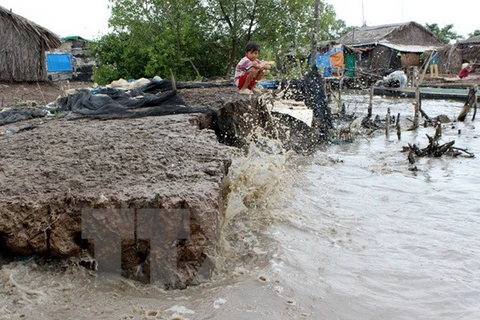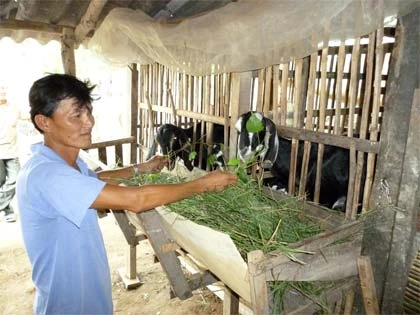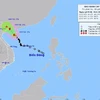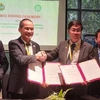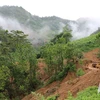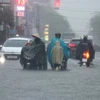Hanoi (VNA) – Most Vietnamese cities lack the capacity to confront climate change challenges, experts say, calling for greater preparedness efforts.
Cities have to be ready to adapt to new situations and unexpected developments, ensuring essential services to residents at all times, they add.
Surveys done by the Urban Development Agency under the Construction Ministry have found cities in mountainous areas particularly vulnerable to natural calamities.
In Lao Cai city, capital of Lao Cai province, and Gia Nghia town, Dak Nong province in the Tay Nguyen (Central Highlands) region, it was found that transportation facilities and potable water supply systems were not equipped for emergency situations.
The studies also found that the early warning systems for storms and flashfloods were not completed in several cities.
In the Tay Nguyen region, urban areas like Gia Nghia have not been able to supply residents with clean water during prolonged drought, badly affecting daily life and production.
Urban development plans prepared by local administrations failed to include solutions for climate change impacts, the agency found.
A similar situation has also been seen in major cities. For instance, HCM City has been suffering flooding on a regular basis because 72 percent of the land area is lower than sea level. About 12 percent of the city’s residents, 47 percent of them poor, are hit hardest by the flooding.
From 2005-2011, the central city of Da Nang was hit by 14 storms that destroyed about 15,000 houses and 26,623ha of forests.
According to the Institute for Social and Environment Transition (ISET), about 300 coastal urban areas have been suffering climate change impacts, including flooding, saline intrusion, and big tides; and nearly 150 urban areas in the mountainous areas have been affected by land erosion, flash floods, and drought.
Experts emphasise that not factoring climate change in the urban planning process has not just made cities more vulnerable, it has also worsened the impacts.
In many urban areas, infrastructure development has not kept pace with increasing population. For instance, most areas do not have separate drainage systems for rainwater and wastewater, and in some cases, existing systems are so degraded that they meet just 60 percent of demand.
“Climate change is unpredictable and variable,” Nguyen Hong Tien, head of Technical Infrastructure Department under the Construction Ministry told Nhan Dan Cuoi Tuan (The People) Weekly.
“Meanwhile, urban cities’ infrastructure works have not been designed and built to respond to specific natural calamities,” Tien said.
“According to weather experts, new records are likely in terms of temperature and rainfall as well as frequency of natural calamities in the coming years. So the losses suffered will be much worse if preventive measures are not prepared,” he said.
Bach Tan Sinh of the Institute for Science and Technology Strategy and Policy said there were many shortcomings in getting urban areas adapt to climate change in Vietnam.
"These include lack of capacity among local administrations, lack of investment and weak knowledge and awareness among both officials and the general public," he said.
"At present, there are no regulations on associating measures of climate change adaption with the socio-economic development in general and urban development plans in regular," he added.
Tien called for the development and application of advanced space and remote sensing technologies to get early warnings about natural disasters as well as development of infrastructure adaptable to climate change impacts, including natural disasters.-VNA
Cities have to be ready to adapt to new situations and unexpected developments, ensuring essential services to residents at all times, they add.
Surveys done by the Urban Development Agency under the Construction Ministry have found cities in mountainous areas particularly vulnerable to natural calamities.
In Lao Cai city, capital of Lao Cai province, and Gia Nghia town, Dak Nong province in the Tay Nguyen (Central Highlands) region, it was found that transportation facilities and potable water supply systems were not equipped for emergency situations.
The studies also found that the early warning systems for storms and flashfloods were not completed in several cities.
In the Tay Nguyen region, urban areas like Gia Nghia have not been able to supply residents with clean water during prolonged drought, badly affecting daily life and production.
Urban development plans prepared by local administrations failed to include solutions for climate change impacts, the agency found.
A similar situation has also been seen in major cities. For instance, HCM City has been suffering flooding on a regular basis because 72 percent of the land area is lower than sea level. About 12 percent of the city’s residents, 47 percent of them poor, are hit hardest by the flooding.
From 2005-2011, the central city of Da Nang was hit by 14 storms that destroyed about 15,000 houses and 26,623ha of forests.
According to the Institute for Social and Environment Transition (ISET), about 300 coastal urban areas have been suffering climate change impacts, including flooding, saline intrusion, and big tides; and nearly 150 urban areas in the mountainous areas have been affected by land erosion, flash floods, and drought.
Experts emphasise that not factoring climate change in the urban planning process has not just made cities more vulnerable, it has also worsened the impacts.
In many urban areas, infrastructure development has not kept pace with increasing population. For instance, most areas do not have separate drainage systems for rainwater and wastewater, and in some cases, existing systems are so degraded that they meet just 60 percent of demand.
“Climate change is unpredictable and variable,” Nguyen Hong Tien, head of Technical Infrastructure Department under the Construction Ministry told Nhan Dan Cuoi Tuan (The People) Weekly.
“Meanwhile, urban cities’ infrastructure works have not been designed and built to respond to specific natural calamities,” Tien said.
“According to weather experts, new records are likely in terms of temperature and rainfall as well as frequency of natural calamities in the coming years. So the losses suffered will be much worse if preventive measures are not prepared,” he said.
Bach Tan Sinh of the Institute for Science and Technology Strategy and Policy said there were many shortcomings in getting urban areas adapt to climate change in Vietnam.
"These include lack of capacity among local administrations, lack of investment and weak knowledge and awareness among both officials and the general public," he said.
"At present, there are no regulations on associating measures of climate change adaption with the socio-economic development in general and urban development plans in regular," he added.
Tien called for the development and application of advanced space and remote sensing technologies to get early warnings about natural disasters as well as development of infrastructure adaptable to climate change impacts, including natural disasters.-VNA
VNA

